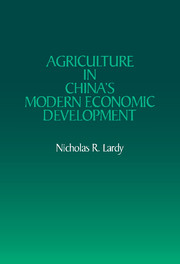Book contents
- Frontmatter
- Contents
- List of tables, figures, and maps
- Preface
- Map 1 The provinces of the People's Republic of China
- 1 The role of agriculture
- 2 Planning and allocative efficiency
- 3 Prices and intersectoral resource transfers
- 4 Living standards and the distribution of income
- 5 Prospects for reform
- Appendixes
- Notes
- References
- Index
- Frontmatter
- Contents
- List of tables, figures, and maps
- Preface
- Map 1 The provinces of the People's Republic of China
- 1 The role of agriculture
- 2 Planning and allocative efficiency
- 3 Prices and intersectoral resource transfers
- 4 Living standards and the distribution of income
- 5 Prospects for reform
- Appendixes
- Notes
- References
- Index
Summary
This study arises from an effort to understand several paradoxes in Chinese agricultural development. The first of these is the puzzling intertemporal path of output and productivity growth. Even after recovering quickly from the disruptions of the civil war by 1952, agricultural growth continued to be rapid from 1953 through 1957, when there were few industrial inputs used in farming and little evidence of technological change. After the mid-1960s technical change was impressive. Due to considerable investments in water control in the 1950s and the development of a chemical fertilizer industry in the early 1960s, China independently developed and began to disseminate high-yield short-stalk rice varieties on a significant scale several years prior to commercialized production of comparable varieties developed by the International Rice Research Institute in the Philippines. By 1977 these fertilizer-responsive high-yield varieties were cultivated on 80 percent of all China's rice area, while adoption was limited to about 25 percent elsewhere in Asia. Significant though less rapid technical innovations were achieved in the development of new varieties of wheat, corn, sorghum, and some other crops. Paradoxically, however, the rate of growth of cereal production from the mid-1960s to 1977–78 was no more rapid than or even somewhat below the pace of development in the First Five-Year Plan (1953–57).
- Type
- Chapter
- Information
- Agriculture in China's Modern Economic Development , pp. ix - xiiiPublisher: Cambridge University PressPrint publication year: 1983



